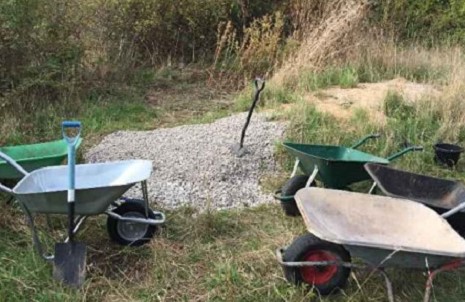This summer, English Heritage is encouraging its visitors to explore England’s historic sites using the five senses of sight, hearing, taste, touch and smell, in a bid to help them connect more deeply with the past.
To provide inspiration, the charity has reintroduced the much-loved ‘Ministry of Works’ signs. Often censorious in the past, the new signs are a playful update on the original – cautioning visitors not to miss out on sensory experiences, such as removing their shoes and standing where history happened or appreciating memorable views that have remained unchanged for centuries.
In addition to the signs, which will be found in the grounds of numerous English Heritage sites across the country, the charity has created a visual guide outlining the ‘50 Ways to Explore using your Senses’ on its website. It includes suggestions such as feeling the chill of ancient stones, tasting heritage produce grown in historic kitchen gardens, taking on new perspectives from the vantage points of historic figures and sniffing out the onsite animals.
Collated by English Heritage historians, the list is designed to transport visitors back in time to enjoy the same experiences as those who have gone before. A shorter, family-friendly version of the guide is also available to download and print for visitors to take with them to their nearest English Heritage site.
Louise Crawley, landscape advisor and historian at English Heritage, explains: “Throughout the centuries, the properties in our care have been homes, workplaces and places of worship to many thousands of people. This summer, we’re inviting visitors to escape from their own lives for a moment and, by using their senses to engage with their surroundings, walk in the footsteps of England’s vast array of historic figures – seeing, hearing, smelling, tasting and touching the very same things that they did.
“Listen to the crunch of gravel underfoot at Down House, which Charles Darwin would have heard on his daily thinking walks. Feel the wind pounding your face on Hadrian’s Wall, as Roman sentries would have done on duty two thousand years ago. Or scan the view across the Mere from Elizabeth I’s rooms at Kenilworth Castle, imagining it filled with water as it was when she looked out upon it.
“In the past, much pleasure would have been derived from simple sensations such as smell, touch and sound. In today’s world, where we’re constantly overstimulated and expected to be at the end of a phone 24/7, it can be difficult to stop and connect with our environment. We hope that our visitors will be inspired to take the time to focus on the sensations around them and, in doing so, form a deeper understanding of the lives of those who went before.”
The senses signs will be at English Heritage sites from today until the end of July. English Heritage’s ’50 Best Ways to Explore with your Senses’ can be found in full on the website. They are:
- Sniff out our animals – many of which played an important role historically at our sites, from horses at Audley End and donkeys at Carisbrooke Castle to Tamworth pigs at Boscobel House.
- Smell the cordite and gunpowder at castles where we still fire historic cannon and big guns like Dover and Pendennis Castle.
- Listen out for the chiming of clocks and the tolling of bells in our country houses and castles. Such as the bells of St Mary’s Church – built within the walls of Portchester Castle – the oldest of which dates from 1589 and was (reportedly) installed following a visit by Queen Elizabeth I. Visitors to the Hampshire coastal fort can breathe in Portchester’s salty sea air and hear the same sounds that the tolling bells have been making since the 17th century.
- Touch the marks left by the chisels of ancient stonemasons on the stones at numerous castles, abbeys and Hadrian’s Wall.
- Taste the produce still grown in our historic kitchen gardens – asparagus and potatoes are among the season’s stars.
- Feel the grass under your feet and inhale the centuries-old scent of freshly cut and rolled lawns.
- Smell the scent of historic varieties of rose and feel the softness of their petals contrasting with the sharpness of the thorns. Keeping old varieties in our gardens add perfumes and scents which might have been recognisable to visitors in the past. At Carisbrooke Castle, the heavily scented Rosa ‘Boule de Neige’ dates from 1837.
- Touch the bark of our trees including those planted by Queen Victoria and Prince Albert at their seaside home, Osborne, on the Isle of Wight.
- Hear the sounds of gardeners at work using tools which have hardly changed in a century; the squeak of a wheelbarrow or the clip of the shears.
- Smell the pages of history in our historic book collections and libraries.
- Be dazzled by vibrant summer bedding in formal parterres – a fashionable favourite of Victorian garden designers.
- Listen out for the calls of summer-visiting birds like swifts and swallows, the sounds of which were often noted by Victorian and Edwardian gardeners in their diaries.
- Hear the noise of insects such as bees and grasshoppers in long grass and amongst the flowers; precious habitats – and more plentiful in the past – which we’re now protecting and restoring.
- Listen to the sound of water in our gardens and marvel at the historic engineering that created water jets, cascades, dams and fountains, such as the grand Perseus and Andromeda Fountain at Witley Court.
- See the shapes of clouds, birds, and historic buildings reflected for centuries in still waters such as the moat at Eltham Palace and the Long Water at Wrest Park.
- Taste sweet strawberries, at the peak of their season in June, at Audley End and join the house’s cook Mrs Crocombe as she demonstrates Victorian ways of cooking with them.
- Peel back the layers of garden design as you see how different owners left their mark. Wrest Park, in particular, is an amalgamation of three centuries of ideas.
- Enjoy wonderful wisteria in full bloom, with its twisted ancient stems and gentle fragrances much admired by Charles Darwin.
- Wonder at the different sizes, shapes and colours of irises, an ancient flower. Native wild irises can be found at Belsay Hall and Kenwood amongst others.
- Seek rare meadow orchids in flower, and watch for bees and other insects visiting these once-common species now endangered by loss of habitat
- See the cloud-like flowers of hydrangeas, only introduced to Britain in the 18th century, and wonder at their different forms and colours.
- Find a flowering tulip tree, first introduced and grown in the British Isles in the 17th century.
- Feel the sharp spikes, soft fronds and rough textures on leaves of exotic plants introduced from around the world, particularly during the Victorian era.
- Hear the sounds of traditional games like the ninepin bowling at Marble Hill or croquet at Walmer Castle.
- Feel the cold of salt sea water as you swim or paddle like Queen Victoria’s family at Osborne beach, who ‘thought it delightful till I put my head under water, when I [thought] I should be stifled.’
- Gain a new perspective from different vantage points: look down on the terraces from the upper windows at Osborne, as Queen Victoria would have done, or look up at the towering rocks in Belsay Hall’s Quarry Garden.
- Hear the crunch of gravel underfoot, and think about the footsteps of those who’ve gone before. At Down House, Charles Darwin went on daily thinking walks. Or at Kenilworth Castle, walk in the footsteps of Elizabeth I and Royal official Robert Langham along the terrace where he described ‘the pleasant whisking wind above’ in his letter from 1575.
- Feel the way the temperatures change as you walk around a garden; find the shade and the sunspots. Wrest Park’s Jemima Marchioness Grey always enjoyed finding shady spots within gardens she visited. Walk in Princess Beatrice’s footsteps through the shade of the fig tunnel at Carisbrooke Castle.
- Whether it’s Charles Darwin’s glasshouse or the conservatory at Wrest Park, feel the heat needed to grow exotic plants in England’s climate.
- Notice the weather - the scents of plants are often stronger after rain or strong sunshine. Historic diaries and letters often made note of the weather, such as William Cresswell’s 1870s diary at Audley End.
- Feel a sense of seclusion – Charles II sought refuge in the garden of Boscobel House, Eltham hosted a tea party during the Second World War, while monks sought isolation in their cell gardens at Mount Grace Priory.
- Channel your sense of discovery and wonder – historic gardens were often designed to delight, surprise or intrigue, with hidden views, avenues and bosquets. At Witley Court, you walk through the ruins of the house to the riot of colour in the parterres below, and the even grander Perseus and Andromeda fountain as you round the corner.
- Listen to the different soundscapes in our historic gardens, hearing just the same sounds as you would have in the past including the hum of visitors chatting. The Duchess of Cleveland was the first to open Battle Abbey to the public in the 19th century.
- Look through the same windows as some of history’s greats, from Darwin and the Duke of Wellington to Queen Victoria and King Charles I.
- Notice the quirky remains from the past, such as the trompe l’oeil paintings at Wrest Park, oddities at Audley End and even a five-legged deer at Swiss Cottage, Osborne.
- See the graffiti left by visitors and others over the centuries, including Bronze Age carvings on Stonehenge and scribbles left by Second Word War Polish special forces at Audley End.
- Feel the warmth of light streaming through the windows of ruined abbeys, and notice the contrast between the light of the exteriors and the relative darkness of the interiors.
- Tour Boscobel House by candlelight – experience the eerie flickering that Charles II would have done, as he hid from Cromwell’s army.
- Touch historic building blocks and stones: From the warmth of a walled garden to the cool of an ice house, or take a tour underneath Dover Castle and feel the cool dampness of the chalk walls of the Second World War secret war time tunnels.
- Feel the ground beneath you and the air in your lungs, as you run across the 1066 battlefield.
- Immerse yourself with soundscape installations. Some evoke people of the past, with interactive benches at Clifford’s Tower bringing local voices to life, whilst others evoke sounds, such as those partially deaf Henrietta Howard would have heard at Marble Hill.
- Call out at Richborough’s Roman amphitheatre and imagine the crowds baying for the gladiators to enter the arena.
- Listen to the sea pounding the cliffs below Tintagel Castle – the same atmospheric sounds that inspired Arthurian legend.
- Search the Stonehenge landscape for prehistoric remains, and, in June, welcome the summer solstice with music and dancing as people have done for thousands of years
- Feel the wind whistling around Whitby Abbey, giving a sense of why it has inspired so many myths and legends.
- Stand sentry at a Roman site and scan the landscape around you.
- Look at the architecture across our sites and see what different ideas of wealth and display people had through time, for instance the elaborately detailed architectural carving of the west front at Castle Acre Priory reflect the belief of the Cluniac monks that God should be worshipped with material things, as well as inwardly.
- Listen to the ‘whirr’ at Stott Park Bobbin Mill to be transported to the time of the Industrial Revolution.
- Be transported by melodic sounds of the piano in the Library at Audley End, and medieval music from traditional instruments at living history events and re-enactments across the country.
- And finally, watch the world rush by from the centuries-old battlements and towers of our castles, from Carisbrooke Castle on the Isle of Wight to Carlisle Castle in the North West.











